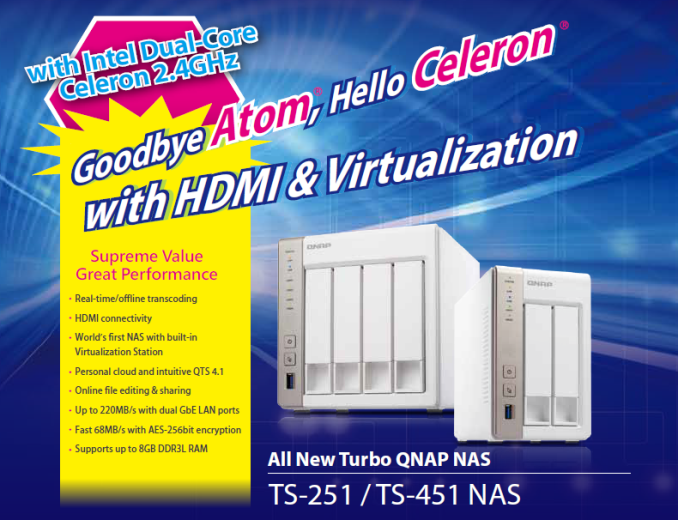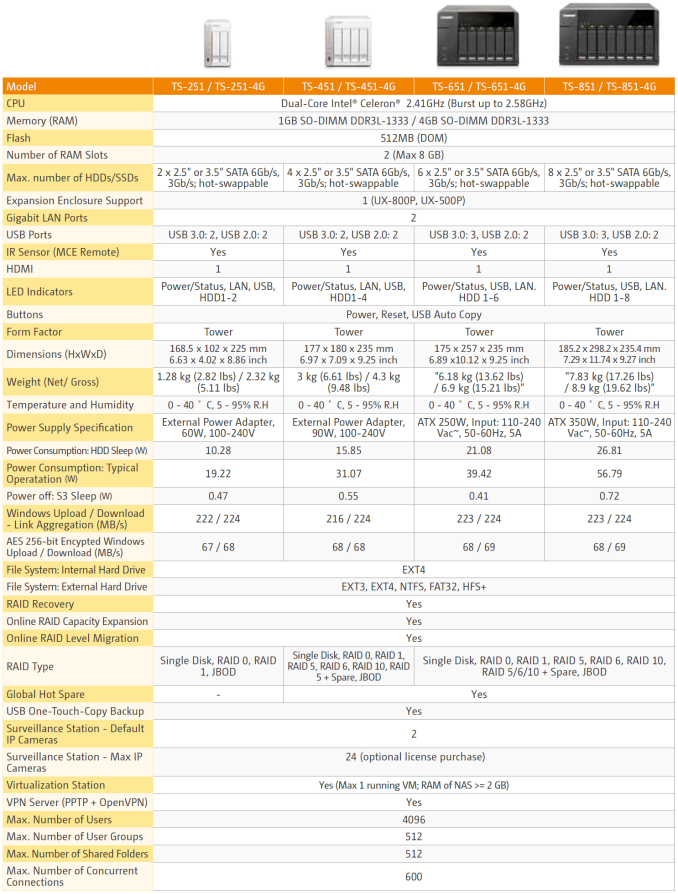QNAP TS-x51 NAS Series: Intel Quick Sync Gets its Killer App
by Ganesh T S on June 22, 2014 6:45 PM EST
Introduction
At Computex 2014, we visited QNAP and came away with a lot of information (some of which we had already seen at CES). After Computex, QNAP got in touch with me to better explain the various features of the newly introduced TS-x51 series (which was not at CES). And, boy, was I floored?! Usually, you don't see me getting very excited over product announcements. They usually get a small write-up with analysis in our pipeline section. However, I believe that QNAP's TS-x51 family has the capability to revolutionize the NAS market for home users and media enthusiasts, particularly in the way it utilizes Intel Quick Sync technology. It also gives us an opportunity to understand the state of the market and where it is headed.
The consumer / SOHO / SMB NAS market (which, in our definition, is comprised of units costing less than $5K) has two major platform vendors. In the cost-sensitive low power / performance segment, we have Marvell, with its ARM-based SoCs. Units requiring higher processing power (where cost is not a primary factor) have typically utilized Intel's x86 platforms. Over the last year or so, the delineation has been blurring quite a bit. Marvell's ARMADA 370 is no slouch when it comes to CPU performance, and it integrates a healthy number of PCIe and SATA lanes. On the other hand, Intel realized that its Bonnell-based D525 and D27xx-based solutions for the NAS market (which required an additional PCH) were not particularly power or cost efficient. While announcing its Silvermont architecture last year, Intel mentioned that the Bonnell follow-up would be part of multiple SoCs for microservers (Avoton) as well as other infrastructure equipment (Rangeley). It was widely expected that NAS vendors would move to Silvermont soon for their x86-based units. We were expecting some announcements at CES, but there was really nothing new.
QNAP's TS-x51 series has been introduced into the market just as it is on the verge of a major change. The details of the various members of the TS-x51 series are provided below. The Celeron CPU mentioned in the first row happens to be the J1800.
Before analyzing the product line and its features, let us take a short detour to understand Intel's play in this market.











49 Comments
View All Comments
ganeshts - Monday, June 23, 2014 - link
In a comment on another recent article, one of the readers stressed that deinterlacing is broken in the Linux drivers for the iGPU. I will check on the status with a review sampleDanNeely - Sunday, June 22, 2014 - link
Two questions, the first is a repeat from the initial announcement a week ago. What virtualization platform/virtual drive container format(s) is supported?The second is, why assume the additional USB3 is done by consuming a PCIe lane instead of by sticking a USB3 hub onboard as is common with current generation motherboards.
modulusshift - Sunday, June 22, 2014 - link
It would consume a PCIe lane either way. He's talking about total lanes from the CPU, not just the number a motherboard would expose like on normal desktops.ganeshts - Monday, June 23, 2014 - link
I am not sure I understand the question entirely, Dan.Are you saying that current generation mobos have the ability to make a single USB 3.0 port from the PCH appear as multiple USB 3.0 ports on the board, i.e, is there a 'USB 3.0 port multiplier' that you are talking about?
As modulusshift indicates, most of the NEC / Fresco Logic / ASMedia based USB 3.0 ports that I see in the motherboards all communicate with the PCH using a PCIe lane.
DanNeely - Monday, June 23, 2014 - link
Yes. A lot of the current generation of boards offering 8 or more USB3 ports that have been reviewed on this site recently are being called out for using a cheaper USB3 hub chip (like what would be inside a 2/4 port USB3 hub on your desk) instead of a PCIe-USB3 chip like in the previous generation.4 of 5 mobo reviews on the front and second page call the board out for using at least on hub to add USB3 ports, just search the first page of the review for the word hub (the 5th only had 6 ports and presumably didn't need one):
http://anandtech.com/show/8045/asrock-z97-extreme6...
http://anandtech.com/show/7965/asus-z97-deluxe-nfc...
http://anandtech.com/show/7966/msi-z97-mpower-max-...
http://anandtech.com/show/7964/gigabyte-z97x-ud5h-...
ganeshts - Monday, June 23, 2014 - link
Got it! Let me see what QNAP comes back with, and I will update the article accordingly.DanNeely - Monday, June 23, 2014 - link
Not a problem. This is something fairly new; and unfortunately appears to be occurring at all pricepoints. I'm mostly ok with doing it on budget boards; but for higher end ones I'd much rather have the option of a 2:4 or 4:8PCIe lane PLX and PCIe-USB3 controllers powering all the ports, rather than have to worry about where I connect high bandwidth devices in the future to avoid bottle-necking. I'm really hoping skylake's chipset will have enough native usb3 ports to make this generation's designs a one off aberration.ganeshts - Wednesday, June 25, 2014 - link
Dan,Virtualization answers from QNAP: OVA, OVF, QVM, XML, VMX.
Confirmed that an USB 3.0 hub chip is being used
SATA - PCIe bridge list update in the article.
extide - Monday, June 23, 2014 - link
No, if you used a USB 3.0 HUB then it would not use a PCIe lane, and that would leave you with two PCIe x1 lanes, so you could add two controllers (ex for the 8-bay you would need a 4-port and a 2-port).name99 - Sunday, June 22, 2014 - link
I find the premise of the article ("Intel Quick Sync Gets its Killer App") to be quite bizarre.In the Apple world, QuickSync has had its killer app for some time supporting remote desktops and video sent from a Mac to an AppleTV. For remote desktops in particular, while this was previously done with software encoding, the lowered latency of QuickSync makes a noticeable difference to the usability if you're connected via a high bandwidth connection. I expect there are substantially more people using OSX ARD than will ever buy this particular NAS.
There are probably similar use cases happening on Windows, but I don't know much about that side of the fence.
My point is not to criticize the NAS or talk up OSX; it's simply to point out that the article subtitle is more than a little ridiculous, suggesting, as it does, that poor little QuickSync was just out there languishing in the world with everyone ignoring it until this NAS came along and showed the world how to utilize it.